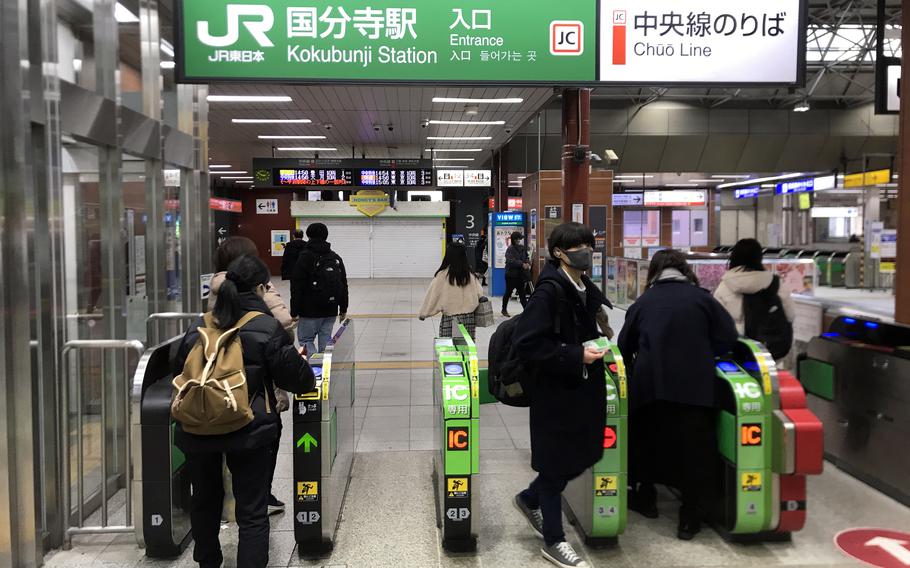
Commuters pass through Kokubunji Station in western Tokyo, Friday, Jan. 3, 2023. (Seth Robson/Stars and Stripes)
TOKYO – Some people in western Tokyo are living with elevated levels of toxins associated with firefighting foam, according to a survey carried out on behalf of a group of concerned citizens.
Tests of 87 people living near the Tama River in November found nearly all had PFAS contamination in their blood, Kyoto University associate professor of public health Koji Harada, who carried out the tests, said in a report provided Wednesday to Stars and Stripes.
PFAS, short for poly and perfluoroalkyl substances, is a class of chemicals linked to an increased risk of certain tumors of the liver, testicles, breasts and pancreas, according to the American Cancer Society. The U.S. Environmental Protection Agency updated its health advisories in June to say no level of PFAS chemicals, which include PFOS and PFOA, is safe in drinking water. The synthetic compounds accumulate in the body over time, according to the agency.
PFAS was widely used in manufacturing to make coatings and products that resist heat, oil, stains, grease and water, according to the Centers for Disease Control and Prevention. Its constituent chemicals are also found in aqueous film forming foam that has been linked to contamination on military bases in the United States.
The citizens’ group tested people ages 21 and 91, mostly living in Kokubunji city, according to Harada’s report. Kokubunji is downstream and about 6 miles east of Yokota Air Base, home to a U.S. military community of about 12,000 people.
PFAS levels in those residents were higher than levels detected during tests of 119 people nationwide by the Ministry of the Environment in 2021, according to Harada’s report.
The results were compared to German standards, according to a Kyodo News report on Wednesday.
Of 87 people, 21 had exceeded the German standard level for one type of PFAS and six exceeded the level for another type, according to Harada’s report.
“It is believed that the PFAS concentration in blood is high among the residents in the Tama area,” the report said.
The toxins likely come from tap water, but work is needed to determine how much exposure comes from other sources such as food and soil, according to the report.
The Tokyo Metropolitan Government in 2019 detected high levels of contaminants in wells in the Tama area and stopped using water from three purification plants in Kokubunji and Fuchu cities, Yukio Negiyama, co-leader of the residents’ group, told Stars and Stripes by phone Wednesday.
“Residents had been drinking the water for more than 10 years, so we wanted to find blood concentration level,” he said.
Foam used by firefighters on Yokota could be a source of the contamination, Negiyama said.
In 2012, nearly 800 gallons of concentrated firefighting foam seeped into the ground from a storage tank at Yokota, according to an Air Force spill report quoted in an Aug. 15, 2020, Asia-Pacific Journal article.
But private companies may account for the contamination, Negiyama noted. The Tama area is home to many factories, including aerospace manufacturers. The citizens’ group hopes the Japanese government and the Tokyo Metropolitan Government will identify the source of contamination, he said.
The residents’ group has taken samples from another 280 residents and plans to conduct tests for 600 people by mid-March, Negiyama said. The group hopes to be able to announce those results by April or May.
The Air Force is committed to the well-being of the community and will continue to coordinate with the government of Japan to remain compliant with international obligations, Yokota spokesman 1st Lt. Danny Rangel said in an email Wednesday.
“Yokota Air Base continues to conduct operations with careful consideration for the health and safety of our community,” he said.
Aqueous film forming foam systems on Yokota are out of service, Rangel added.
“A centralized contract is scheduled to remove these systems and substances over the next few years,” he said.
Yokota’s water supply is tested on a regular basis to ensure it is meeting safe drinking water requirements, Rangel said.
“The installation publishes an annual drinking water quality report, which summarizes the quality of water delivered by Yokota Air Base to strengthen public understanding of our water systems,” he said.